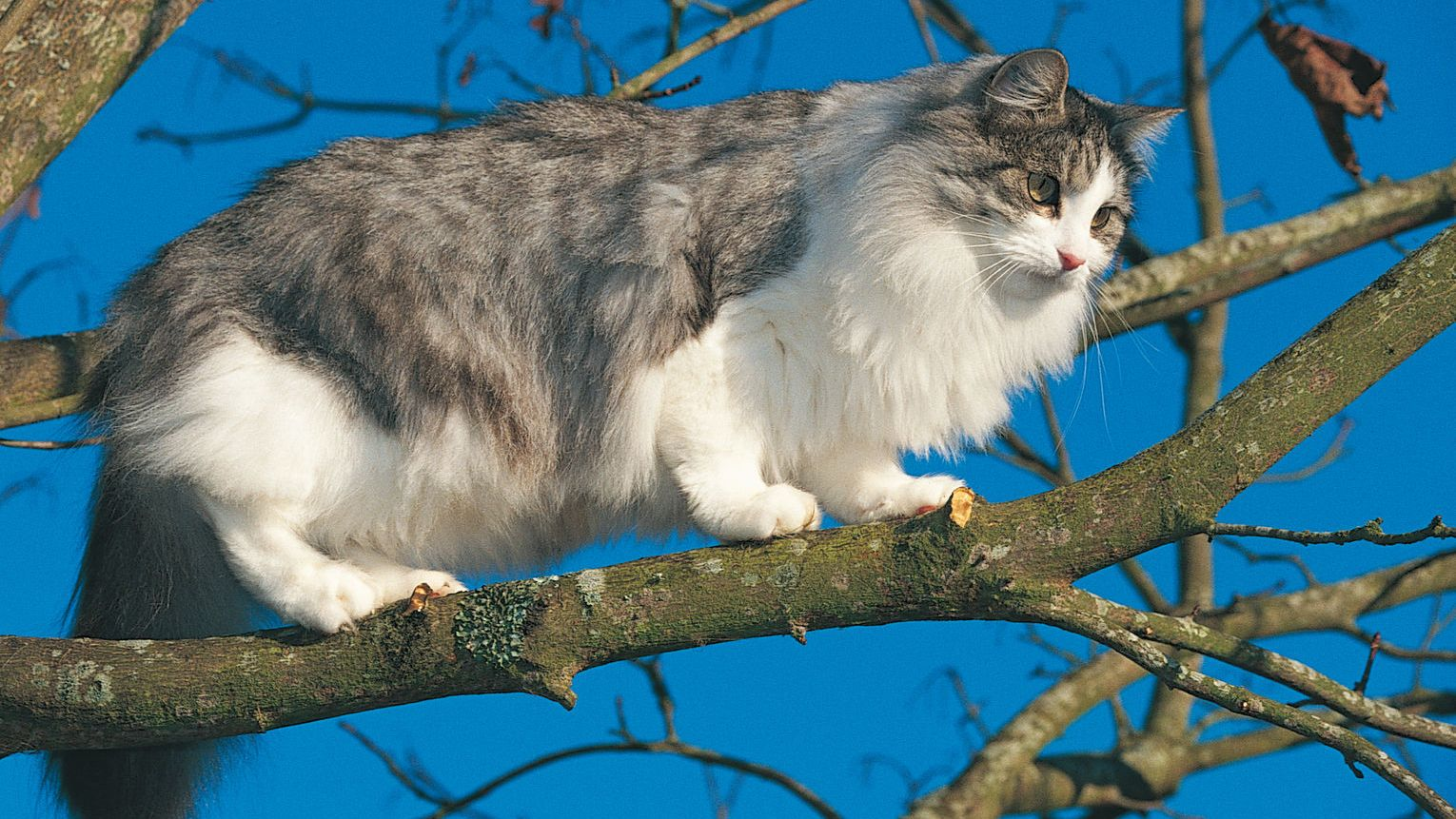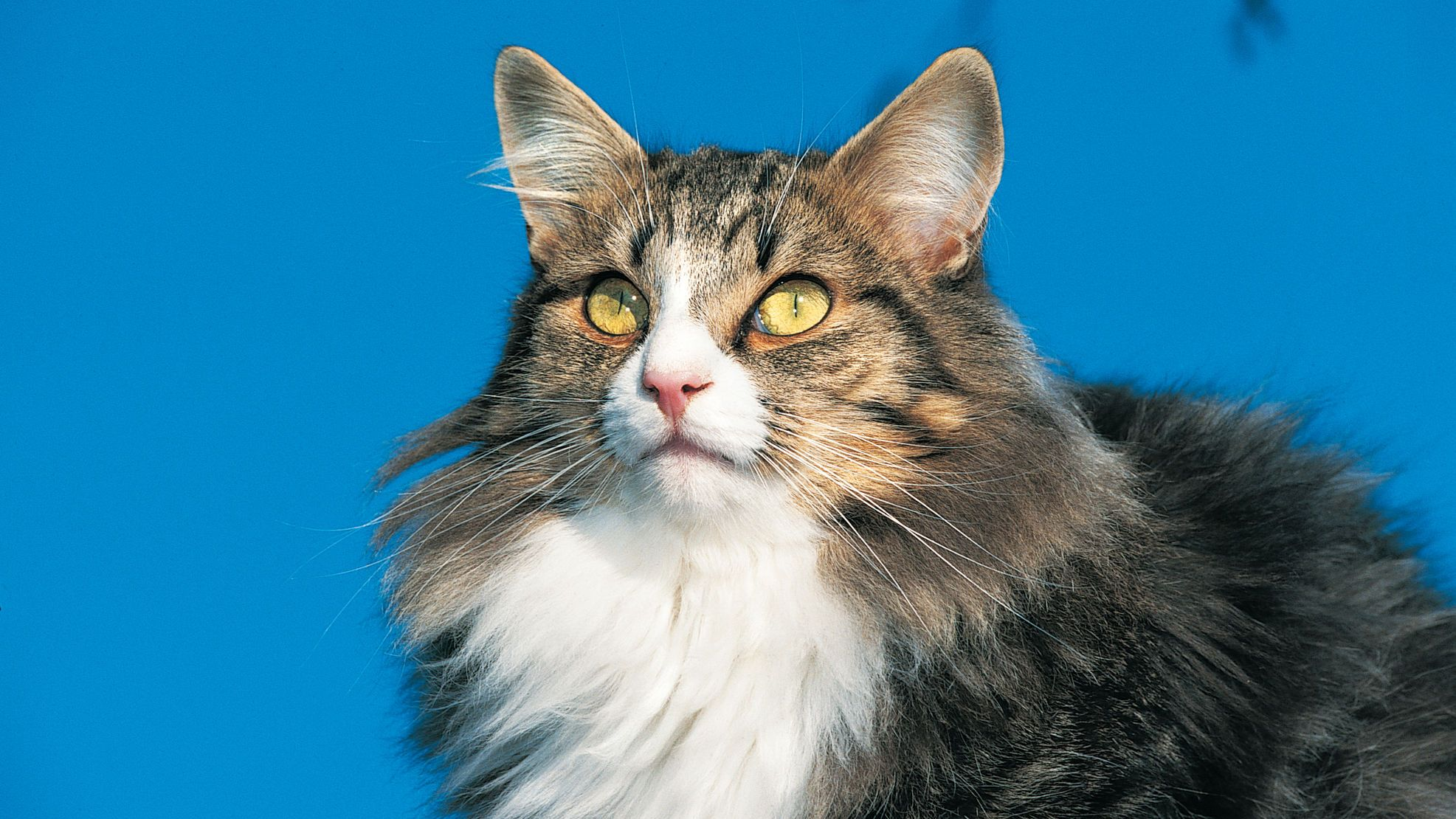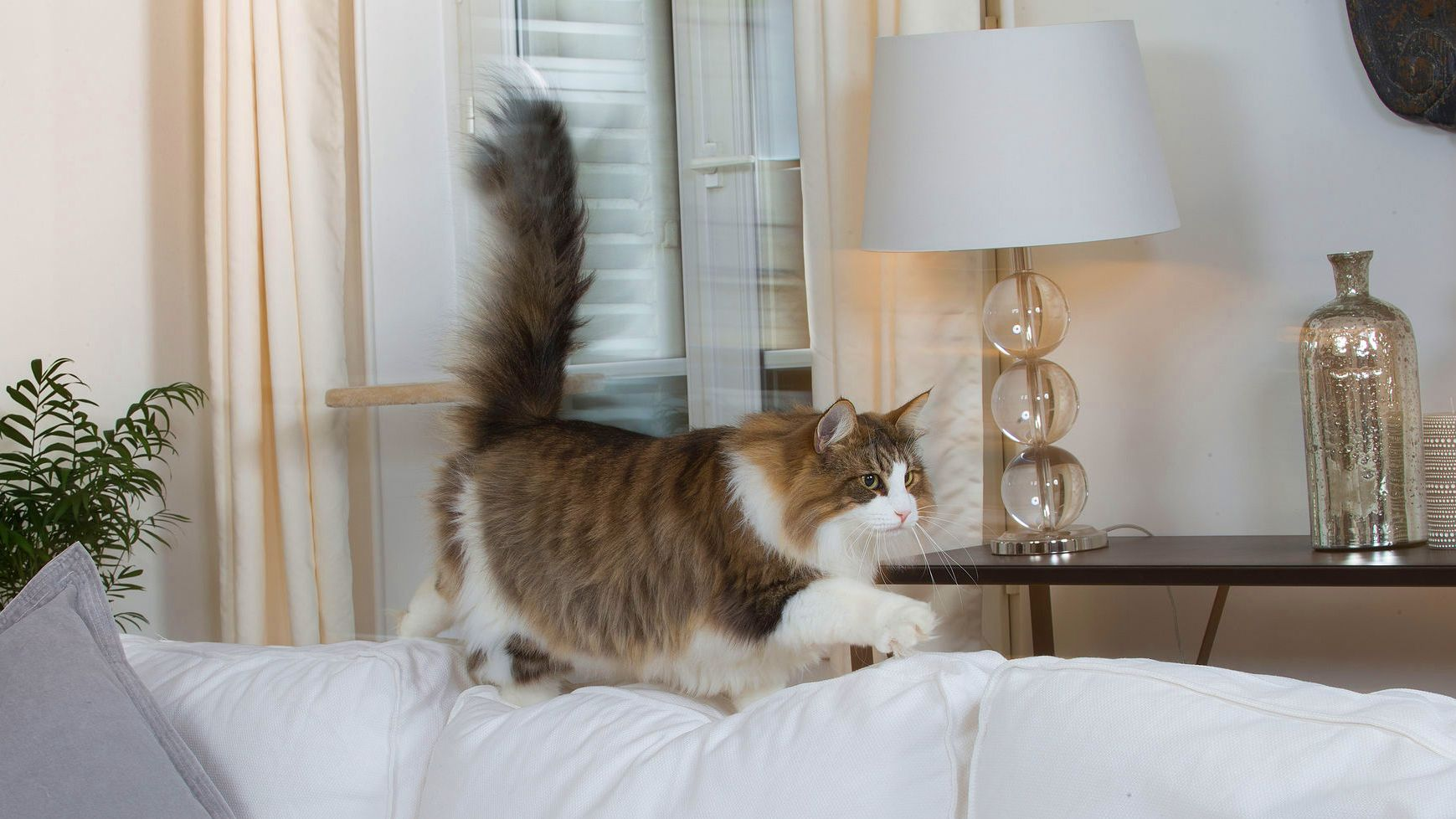Let's talk Norwegian Forest Cats
A gentle giant of the feline world, the Norwegian Forest Cat is friendly, easy-going and often quite playful. This makes them an ideal breed to have around children. Unlike some cats, they form strong attachments to their human families and are also known to be quite affectionate. Then there’s the Norwegian Forest Cat’s impressive stature, voluminous coat and, thanks to those tufted ears, almost lynx-like good looks. Originally from Northern Europe, as the name suggests, they are well suited to colder climes.
Official name: Norwegian Forest Cat
Other names: Norse skogkatt, Skogkatt, Wegie
Origins: Norway
Hair length
4 out of 5Shedding Level
4 out of 5Grooming needs
4 out of 5Energy level*
3 out of 5Vocal
1 out of 5Family pet?*
4 out of 5Compatibility
4 out of 5Can stay alone
2 out of 5Environment (indoor/outdoor)
3 out of 5
| Male | Female |
|---|---|
| Height | Height |
| 23 - 31 cm | 23 - 31 cm |
| Weight | Weight |
| 4 - 9 kg | 3 - 7 kg |
| Life stages | |
|---|---|
| Kitten | Adult |
| 4 to 12 months | 1 to 7 years |
| Mature | Senior |
| 7 to 12 years | 12+ |

Get to know the Norwegian Forest Cat
All you need to know about the breed
With a name that’s straight out of a fairy tale, the Norwegian Forest Cat more than lives up to its billing. Known for their almond-shaped eyes, impressive size and lustrous coat, they could indeed be a character in a storybook and look more like a wild animal than a family pet.
Funnily enough, though, while it’s true that they hail from the Norwegian forests after which they are named, the Norwegian Forest Cat may descend originally from domestic cats. In fact, it is widely believed that their ancestors were household pets of the Norwegian Vikings. Later, the breed went on to become established in the wild Nordic woodlands, gradually becoming more feral and growing their longer, thicker coat to cope with the harsh Scandinavian climate.
Today, while they remain a hardy, robust and self-assured animal, the Norwegian Forest Cat also has a lovely, sociable temperament that belies their background. As such, they can get on well with children and other pets—and even with dogs sometimes.
As one of the largest breeds of domestic cat, a fully grown Norwegian Forest Cat can reach a top weight of around 20lb (9kg). A strong, powerful and agile animal, not unlike the Maine Coon, they are exceptionally good at climbing due to their muscular bodies and strong claws. The Norwegian Forest Cat is also one of the only breeds to like water, thanks to their water-shedding hair, so watch out if you have a fishpond—they may even try to jump in your bath!
While it’s true that they are best suited to an outdoor lifestyle, they can adapt well to life indoors as long as they have plenty of toys and activities to keep them occupied. A highly intelligent breed with a playful personality, Norwegian Forest Cats are very interactive animals who also enjoy games with their owners. The Norwegian Forest Cat has a good life expectancy, too, reaching an average age of 14 to 16 years.
Increasingly popular over the years, they were designated the official cat of Norway in the 1950s. Nowadays, Norwegian Forest Cats feature among the 20 most popular cat breeds in the world.

Two facts about Norwegian Forest Cats
1. Quite the climber
According to Norse folklore, the Skogkatt (to use the Norwegian Forest Cat's native name) was a "mountain-dwelling fairy cat." Legend has it that they had the ability to climb sheer rock faces that other breeds could never pull off.
2. One-of-a-kind color
The Norwegian forest Cat has a coat of potentially many colors—from chocolate to sable and lavender. But did you know that a unique color has been identified in the breed? This is an amber that appears in two different shades.
History of the breed
Although the precise origins of the Norwegian Forest Cat are not known, it is thought that their ancestors were brought over to Norway by the Vikings around 1,000 AD. While many believe that today’s breed descends from a short-haired variety in Great Britain, they may also have their roots in the Siberian and the Turkish Angora (both long-haired cats) from Russia and Turkey, respectively.
In any event, over the years, colonies became established in the Norwegian forests and eventually adapted to the cold, harsh climate there. Later, they were utilized for their hunting skills by local farmers to keep the local mouse populations in check, but didn’t become established as a domestic pet until relatively recently.
In fact, during World War II, the Norwegian Forest Cat almost became extinct altogether. It was only thanks to the Norwegian Forest Cat Club, which had been set up in 1938, that the breed endured after they set up an official breeding program.
The Norwegian Forest Cat was finally registered as a breed in Europe in the 1970s. However, it wasn’t until 1989 that they were accepted as a breed in the UK. Now, they are a highly popular breed of pet cat across Europe and beyond – but especially in their native Norway and in France.
From head to tail
Physical characteristics of Norwegian Forest Cats
1.Head
2.Eyes
3.Body
4.Tail
5.Coat

Things to look out for
From specific breed traits to a general health overview, here are some interesting facts about your Norwegian Forest Cat.
It’s important to choose a reputable breeder
This can help reduce the risk of any hereditary conditions. For example, although it happens only rarely, the Norwegian Forest Cat has a genetic predisposition to a neurological disorder known as ‘glycogen storage disease IV’ (or ‘Andersen disease’). This can occur at birth, with some kittens being stillborn, or it can also manifest at five to seven months with progressive decline. Fortunately, a DNA test can be carried out to establish if a cat is clear, so good breeders will be screening for the condition in the parents in order to reduce the risk. If buying a Norwegian Forest Cat kitten, be sure to check with your breeder about this.
Their teeth need some careful attention too
Like other breeds, the Norwegian Forest Cat can be prone to gum and dental problems. This can occur when plaque on the teeth builds up and becomes mineralized leading to what is known as ‘tartar’. This, in turn, can result in gingivitis (gum inflammation) and periodontal disease (affecting the structure around the tooth). As a result, the Norwegian Forest Cat should have their teeth brushed as often as possible. Regular dental check-ups are also recommended and the right sort of diet can help, too. For example, dry food can help remove dental plaque.
Be sure to check their eyes regularly for anything unusual
Another thing to be aware of is that the Norwegian Forest Cat can be susceptible to eye complaints. For example, these can include conditions such as conjunctivitis, glaucoma and retinal dysplasia – the last of which can occur when the kitten is still in the womb or newly born. The important thing is to check their eyes regularly for any sign of discomfort or irritation and, if anything doesn’t seem right, have a chat with your vet who will be able to advise on the best course of treatment. They will also be able to offer regular check-ups for your Norwegian Forest Cat in order to head off any issues.
Tailored Nutrition for Norwegian Forest Cats

Tailored health nutrition has a fundamental role to play in maintaining the health and beauty of Norwegian Forest Cats. Food provides energy to help with vital functions and a complete nutritional formula for Norwegian Forest Cats should contain an adapted balance of nutrients. Feeding them in this way will offer a diet that's neither deficient nor excessive, both of which could have adverse effects on your cat's health.
The following recommendations are for healthy animals. If your cat has health problems, please consult your veterinarian who may recommend an exclusively veterinary diet.
Strong Immune System
Supports the development of the kitten's healthy immune system with the inclusion of clinically proven antioxidants, including vitamins E and C.
Healthy Growth
At 4 months old, a kitten's growth rate changes with rising energy levels to support growing bones and muscles. This formula contains an adapted level of protein, vitamins, and minerals for the final stage of the Sphynx's kittenhood until 1 year old.
Microbiome Support
Combination of prebiotics and highly digestible proteins to help promote a healthy balance of intestinal microbiota for digestive health.

On top of maintaining a healthy urinary function as for all cats, the main nutritional goals for adult Norwegian Forest Cats are:
Manages Hairballs
Long-haired cats living indoors are particularly prone to hairballs. INDOOR LONG HAIR is formulated with a combination of different types of fibers that encourages intestinal transit and helps to facilitate the elimination of the hair your cat swallows every day.
Stool Odor Reduction
A lack of exercise may lead to a slower intestinal and smelly stools. INDOOR LONG HAIR contains highly digestible protein (L.I.P.) and helps reduce the quantity and odor of stools.
Skin and Coat Health
Skin and coat are the reflection of overall health. INDOOR LONG HAIR contains specific fatty acids including EPA and DHA to help maintain a healthy skin and a shiny coat.

A senior Norwegian Forest Cat - one over the age of 12 - may sometimes have difficulties with absorption, too. To maintain the weight of the aging cat and minimize the risk of deficiency, they should be given an extremely digestible food filled with essential nutrients.
Weight Maintenance
In some senior cats, the level of activity reduces with age, which leads to weight gain. AGING SPAYED/NEUTERED 12+ contains a moderate level of fat to help maintain an ideal body condition.
Healthy Aging Complex
An exclusive complex of antioxidants including lycopene and omega-3 fatty acids to support the body systems through the aging process.
Renal Health
Helps support healthy renal function with a moderate phosphorus level.

Caring for your Norwegian Forest Cat
Grooming, training and exercise tips
With a top weight of around 20lb (9kg), the full-size Norwegian Forest Cat needs a fair amount of physical activity to keep them in shape. As a one-time wildcat, this is a breed that will also benefit from regular access to the great outdoors. However, if this isn’t viable—for example, if you live near a busy road—a good compromise can be an enclosed area in the garden where they can get the best of both worlds in a safe space. Either way, you will want to think up as many activities as possible for them to enjoy at home. As the Norwegian Forest Cat is a consummate climber, they’ll appreciate something to clamber up and down such as an elaborate cat tree with high platforms.
The Norwegian Forest Cat is a true stunner of the feline world, but their thick double coat of long, water-resistant fur does require a bit of care. They will need brushing at least twice a week—and daily during the shedding periods when they can shed a lot. As well as keeping the coat in good condition and avoiding tangles, this will help to prevent any foreign bodies, such as grass seeds, getting trapped in their fur and causing skin abscesses. The Norwegian Forest Cat should also have the corner of their eyes wiped daily, using a different cloth for each eye, and nails clipped as needed. Teeth should be brushed as often as possible and they should have regular dental check-ups.
Known for being a highly intelligent breed, the Norwegian Forest Cat learns fast. They can therefore be house-trained very easily. However, as this is a breed that takes a long time to fully mature, expect kitten antics for some time to come. They are even quite playful into adulthood. As such, they will also benefit from games and activities at home, as well as plenty of interaction with their owners. Although they like to have the company of their human families, and are usually great with other pets, the Norwegian Forest Cat can be a little shy around strangers. Selecting a kitten that comes from a breeder who practices early handling and socialization can help with this.
7/7
All about Norwegian Forest Cats
There is actually no such thing as a “hypoallergenic” cat. The allergen that causes reaction in people is called ‘Fel d1’ and is produced in the glands. This is particularly present in their saliva, so, when cats groom themselves, they spread the allergen over their body. But it has nothing to do with the type of hair (i.e. long or absent) as such.
Other breeds that might interest you
Read more on this topic
Like & share this page